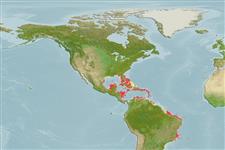>
Syngnathiformes (Pipefishes and seahorses) >
Syngnathidae (Pipefishes and seahorses) > Syngnathinae
Etymology: Micrognathus: Greek, mikros = small + greek, gnathos = jaw (Ref. 45335).
More on author: Jenyns.
Environment: milieu / climate zone / depth range / distribution range
Ecologia
marinhas associadas(os) a recifes; intervalo de profundidade 1 - 21 m (Ref. 52313). Subtropical; 32°N - 33°S
Western Atlantic: Bermuda and the Bahamas to Santa Catarina, Brazil (Ref. 57756); including lower east Florida coast but absent from the Gulf of Mexico except for a single record from Cayo Arcas, Mexico. Dawson (1982) noted that there are two distinct color patterns of this species with no definite intergrades. Some authors are of the opinion that these color extremes represent two different species and should this be true, Dawson stated that Kaup's vittatus has priority over ensenadae with AMNH 7792 documenting the Bermuda occurrence of Micrognathus vittatus.
Tamanho / Peso / Idade
Maturity: Lm ? range ? - ? cm
Max length : 15.0 cm TL macho/indeterminado; (Ref. 7251)
Descrição breve
Chaves de identificação | Morfologia | Morfometria
Raios dorsais moles (total) : 19 - 21; Raios anais moles: 1 - 3. Possess nine (9) different color phases. Similar to Halicampus zavorensis, it has a short snout (2.7-3.7 in HL) with a continuous and essentially linear median dorsal ridges. Different with H. zavorensis in having 17-18 trunk ridges (vs. 14); 32 - 35 tail rings (vs. 36 - 37); and having 18 - 22 dorsal-fin rays (vs. 22 - 23) (Ref. 52313).
Occurs in pockets of coral rubble (low coral growth on white sand bottom), usually in the vicinity of sea fans (Ref. 5521, 7251, 9710). Ovoviviparous (Ref. 205). The male carries the eggs in a brood pouch which is found under the tail (Ref. 205).
Life cycle and mating behavior
Maturities | Reprodução | Spawnings | Egg(s) | Fecundities | Larvas
Male carries the eggs in a brood pouch (Ref. 205).
Robins, C.R. and G.C. Ray, 1986. A field guide to Atlantic coast fishes of North America. Houghton Mifflin Company, Boston, U.S.A. 354 p. (Ref. 7251)
Categoria na Lista Vermelha da IUCN (Ref. 130435)
Ameaça para o homem
Harmless
Utilização humana
Ferramentas
Relatórios especiais
Descarregue XML
Fontes da internet
Estimates based on models
Preferred temperature (Ref.
123201): 25.8 - 28.2, mean 27.4 °C (based on 694 cells).
Phylogenetic diversity index (Ref.
82804): PD
50 = 0.5039 [Uniqueness, from 0.5 = low to 2.0 = high].
Bayesian length-weight: a=0.00037 (0.00016 - 0.00085), b=3.18 (2.99 - 3.37), in cm total length, based on LWR estimates for this (Sub)family-body shape (Ref.
93245).
Nível Trófico (Ref.
69278): 3.3 ±0.5 se; based on size and trophs of closest relatives
Resiliência (Ref.
120179): Elevada, tempo mínimo de duplicação da população menor que 15 meses (Preliminary K or Fecundity.).
Fishing Vulnerability (Ref.
59153): Low vulnerability (10 of 100).
Nutrients (Ref.
124155): Calcium = 80 [38, 191] mg/100g; Iron = 0.927 [0.464, 1.736] mg/100g; Protein = 18.7 [17.4, 19.9] %; Omega3 = 0.171 [0.088, 0.330] g/100g; Selenium = 15.3 [6.4, 38.2] μg/100g; VitaminA = 45 [13, 164] μg/100g; Zinc = 1.21 [0.73, 1.96] mg/100g (wet weight);
